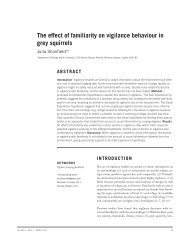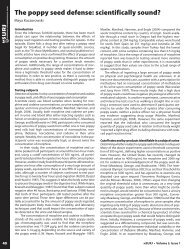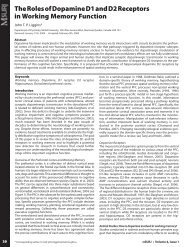the entire issue - McGill Science Undergraduate Research Journal ...
the entire issue - McGill Science Undergraduate Research Journal ...
the entire issue - McGill Science Undergraduate Research Journal ...
Create successful ePaper yourself
Turn your PDF publications into a flip-book with our unique Google optimized e-Paper software.
RESEARCH ARTICLE<br />
Force-fluctuation physics of confined DNA:<br />
probing <strong>the</strong> breakdown of <strong>the</strong> Marko-Siggia<br />
law<br />
Haider Riaz 1 *, Alex R. Klotz 1 , Dr. Walter W. Reisner 1<br />
1<br />
Department of Physics, <strong>McGill</strong> University, Montreal, QC<br />
*Email Correspondence:<br />
haider.riaz@mail.mcgill.ca<br />
Keywords:<br />
Biophysics,<br />
DNA,<br />
Nanotechnology, Elasticity.<br />
Abstract<br />
Introduction: The study of polymers in nanofluidic systems such as nanopores and nanochannels is<br />
an important avenue of research in <strong>the</strong> physical and life sciences today. Complex nanofluidic devices<br />
containing varying topography are ideal for quantifying <strong>the</strong> behaviour of polymers under confinement.<br />
This study investigates <strong>the</strong> Marko-Siggia force-extension relationship under confinement. We measure<br />
<strong>the</strong> transverse fluctuations of deoxyribonucleic acid (DNA) confined between two pits in a nanofluidic slit<br />
to measure <strong>the</strong> potential breakdown of this model.<br />
Methods: We took images of fluorescently tagged single DNA molecules in <strong>the</strong> nanopit array with videofluorescence<br />
microscopy and analyzed <strong>the</strong> standard deviation of <strong>the</strong> peak position along <strong>the</strong> direction of<br />
<strong>the</strong> molecular extension.<br />
Results: We were able to measure <strong>the</strong> parabolic relation between position and <strong>the</strong> strength of transverse<br />
fluctuations. By examining <strong>the</strong> peak variance as a function of slit height, our results indicate that <strong>the</strong><br />
two dimensional version of <strong>the</strong> force-fluctuation relationship may be appropriate in <strong>the</strong> limit of strong<br />
confinement. However, we could not consistently measure <strong>the</strong> absolute length of <strong>the</strong> DNA stretched<br />
between two pits, which prevented us from fully exploring <strong>the</strong> force-extension and force-fluctuation<br />
relationships of confined DNA.<br />
Conclusions: These experiments fur<strong>the</strong>r demonstrate that nanofluidic confinement serves as a useful<br />
tool for testing <strong>the</strong> extreme properties of polymers, and our results suggest fur<strong>the</strong>r investigation into <strong>the</strong><br />
breakdown of <strong>the</strong> Marko-Siggia force law.<br />
Introduction<br />
The development of nanofluidic devices such as nanopores, nanochannels,<br />
and nanoslits has led to significant advancements in many<br />
areas of research (1). These devices have small volumes and provide<br />
constrained dynamics, allowing individual biological molecules to be<br />
studied with remarkable spatial and temporal resolution. Nanofluidics<br />
also have applications in next-generation genetic mapping technologies<br />
(2).The physics of deoxyribonucleic acid (DNA) molecules<br />
under confinement is fundamentally different than in bulk form (3).<br />
The unique behavior displayed by polymers under confinement is<br />
a significant area of study in nanoscience. Understanding it is key<br />
for <strong>the</strong> fur<strong>the</strong>r development of a diverse array of fields ranging from<br />
polymer electronics (4) to polymeric membranes (5).<br />
A polymer is a molecule made up of a number of repeating “monomer”<br />
units in a chain. There is no long-range order in orientation<br />
along <strong>the</strong> polymer, and its structure is described by a random walk<br />
(6). To maximize entropy, a polymer randomly coils with a characteristic<br />
radius. When stretched, <strong>the</strong> number of possible configurations<br />
decreases, and due to <strong>the</strong>rmal fluctuations, <strong>the</strong> polymer will relax to<br />
a more condensed and higher entropy state: <strong>the</strong> polymer tends to<br />
bunch as <strong>the</strong>re are more ways for it to be bunched than stretched.<br />
This phenomenon is known as entropic elasticity. Biological polymers<br />
such as DNA are often described by <strong>the</strong> worm-like chain model<br />
of entropic elasticity, which correctly predicts rigidity over a short<br />
range known as <strong>the</strong> persistence length. This model was tested by<br />
Marko and Siggia (7), who derived <strong>the</strong> eponymous force law relating<br />
<strong>the</strong> force acting on <strong>the</strong> ends of a polymer to its relative extension.<br />
More recently, Baba et al (8) derived a relationship between <strong>the</strong><br />
44<br />
<strong>McGill</strong> <strong>Science</strong> <strong>Undergraduate</strong> <strong>Research</strong> <strong>Journal</strong> - msurj.mcgill.ca









